The 2015 MacBook Review
by Ryan Smith on April 14, 2015 10:15 AM ESTOS X Performance
Now that we’ve had a chance to take a look at the construction and component selection of the MacBook, it’s time to get down the business end of the review: performance.
For the sake of brevity I’m not going to completely rehash how Core M works, especially since we just did an in-depth look at the CPU last week. But briefly, from a performance standpoint Core M behaves a lot more like a modern tablet processor than it does a traditional Intel x86 processor. Which is to say that its performance is heavily tuned around performance bursting and racing back to idle, as opposed to more traditional Intel processors which turbo as well, but overall are also designed to hold at relatively high clockspeeds under sustained workloads. Of course all of this is in part dependent on how OEMs go and design their laptops – go stuff a Core i5 in a Surface Pro 3 and watch it throttle – but at the end of the day the point is that Core M is not designed to offer the same kind of high performance under sustained workloads that Intel’s more powerful processors do.
Core M is at its heart still a power optimized Intel Broadwell design, so despite the different Core M branding it’s not all that far removed from the dual-core Broadwell-U processors in the MacBook Air and 13” Retina MacBook Pro. What sets it apart along with its package and power optimizations are its much lower power threshold – the official TDP is just 4.5W, while it can burst higher for short periods of time – and the fact that it’s designed for systems with less cooling than Broadwell-U. Case in point of course is the MacBook, which utilizes a simple aluminum case without any kind of fans (active cooling). The end result is that for workloads that go longer than a short burst, Core M’s performance is tightly coupled to the cooling capabilities of the laptop it’s in.
Ultimately what this means is that we expect that the MacBook should be able to compete with its larger brothers in those short, bursty workloads that Core M is optimized for, while in sustained workloads it’s going to fall behind MacBook Air and other laptops using Intel’s larger 15W processors.
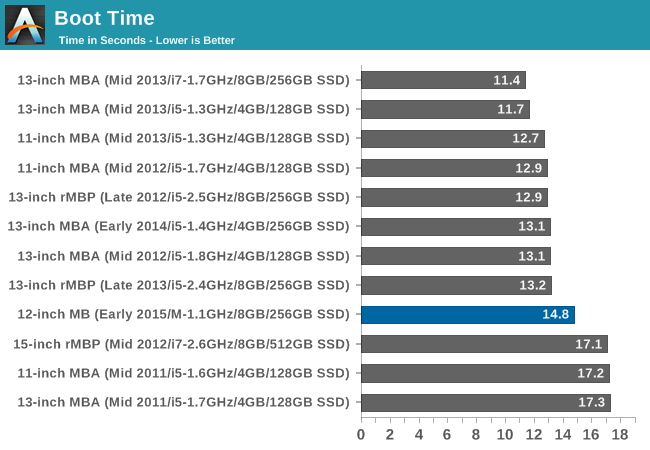
We’ll kick things off quickly with a look at boot time. On an absolute basis the MacBook doesn’t do too poorly, but on a relative basis it’s behind a lot of our other MacBooks. To be clear here this is a historical chart – each machine is running the version of OS X it launched with – so the only Yosemite MacBook here is the 2015 MacBook. Still, whether it’s Core M or Yosemite, it shows that Apple’s boot times here aren’t quite as good as they have been in the past.
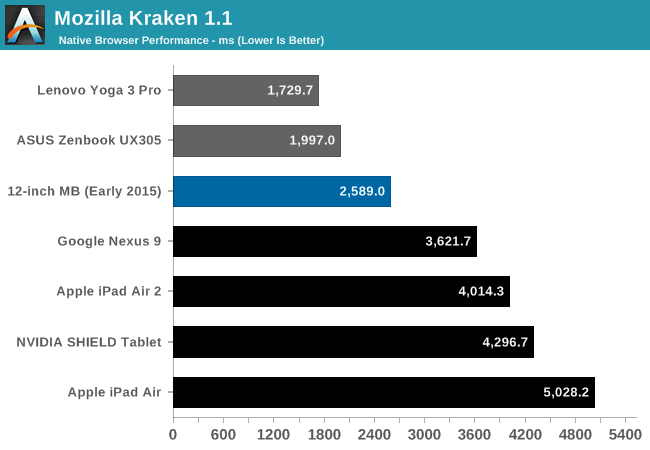
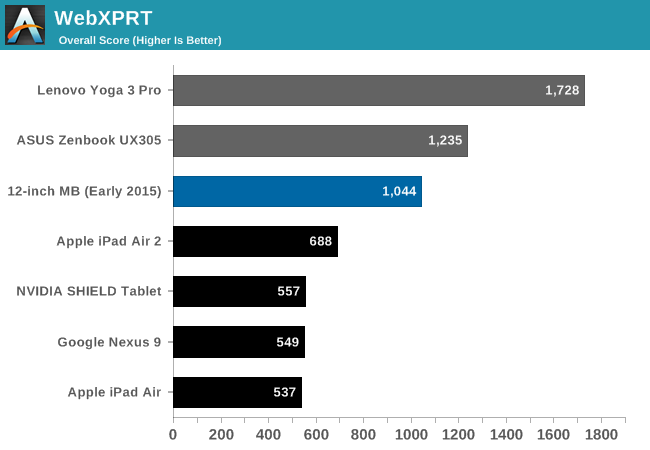
Switching gears, we have an example of a semi-bursty workload with a couple of our web benchmarks. These benchmarks run a number of sub-tests, and as a result the MacBook gets a brief respite between benchmarks. Plus this gives us a chance to compare the MacBook to tablets, including of course the iPad Air 2. Meanwhile since we’ve also just recently looked at several Core M devices, I’ve also included those to provide a point of comparison to other Core M devices.
Truth be told these results are a bit surprising, though not for good reasons. The MacBook ends up being a laggard against both of our other Core M devices. Since each platform is running a high performance browser (either Safari or Chrome) and from hardware capabilities standpoint these Core M devices are all relatively close, I suspect what we’re seeing here is that OS X Safari as not as well tuned as iOS Safari is.
Compared to the tablets on the other hand the MacBook is still well ahead of any of the tablets – as it should be with Core M’s greater power consumption and the larger chassis – but there’s no denying that by scaling down the MacBook so far, the performance gap between tablet and laptop has shrunk significantly. The MacBook is less than 2x faster than the iPad Air 2 in both benchmarks, which means that within a couple of generations it’s likely that the iPad will exceed the current MacBook’s scores. If my earlier hunch about Safari optimizations is correct and OS X needs some more tuning, then the MacBook is farther ahead than what these benchmarks show. Still, it goes to show that although the MacBook is well ahead of tablets, it’s not leaps and bounds ahead like more powerful laptops would be.
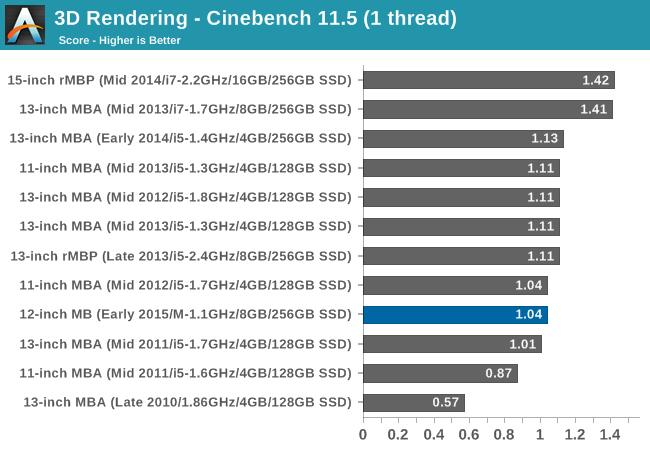
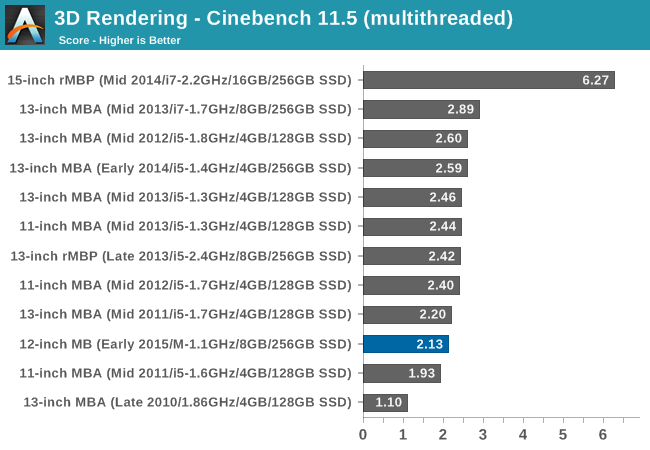
Meanwhile our large collection of Cinebench 11.5 results helps put Core M’s sustained performance in perspective. In both single-threaded and multi-threaded workloads it’s well behind the pack, though in different ways. Single-threaded performance is essentially on par with the 2012 11” MacBook Air (Ivy Bridge), and even as recent as the Core i5-equipped 2014 13” MacBook Air the 2015 MacBook is within 10%. In this case what we’re seeing is a case where a lighter workload allows one of Core M’s CPU cores to stay highly clocked (remember, it turbos up to 2.4GHz), which means it’s actually rather competitive with recent Ultrabooks. Unless forced to throttle, Core M is still Broadwell, and Broadwell flies.
Which means that when Core M is forced to throttle under the multi-threaded workloads, the performance gap widens. Ignoring the rMBP and its 4 cores, where exactly the MacBook places depends in part on the generation of the MacBook it’s compared against, followed by the CPU configuration. The base Core i5s in the MBAs and 13” rMBP are quite capable, with the most powerful of these surpassing the MacBook by upwards of 20%. In that respect the new MacBook is offering multi-threaded performance between the 2011 and 2012 MacBook Airs. On the other hand though we’re talking about the MacBook coming within 20% of larger laptops with much more powerful (15W+ CPUs), so while the MacBook can’t keep up, it’s also delivering quite a bit of performance for its size and power consumption.
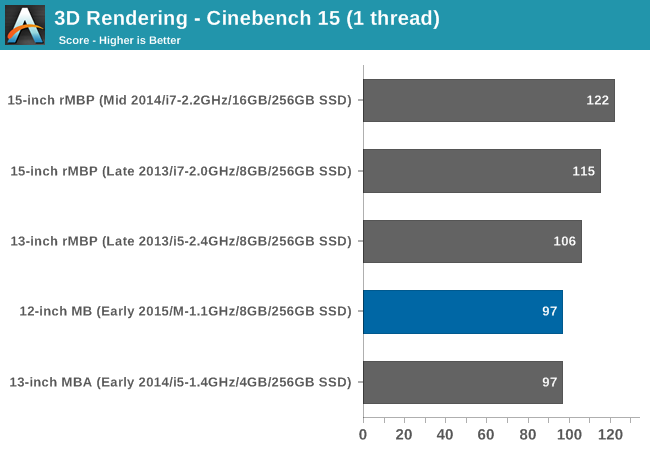
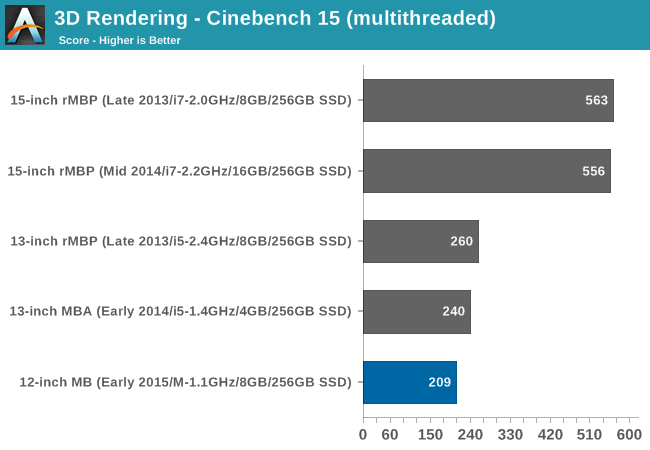
Our more recent Cinebench 15 results on the other hand find the MacBook at the bottom. Though this is in part due to a much smaller dataset we have (and mostly composed of rMBPs), it does drive home the point of just how wide the gap is between the rMBP and the new MacBook. If you want a powerful Mac capable of fast sustained performance, you’re going to want a MacBook Pro. That said, compared to the 2014 13” MBA, we once again see the MacBook holding up well in the single-threaded benchmark, outright tying last year’s larger MBA. This once again handily illustrates how Core M is no slouch with lightly threaded workloads, and how it’s heavily threaded workloads where it’s really going to need to pull back.
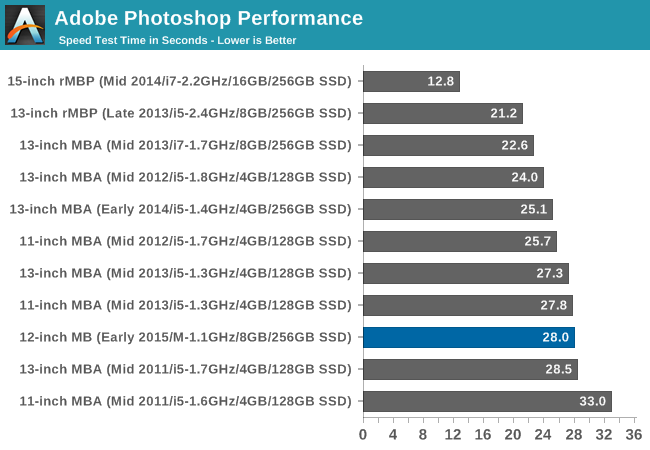
Moving on, we have a look at Photoshop performance with the Retouch Artists Speed Test. This being another multi-threaded test, the MacBook throttles harder and this leaves it towards the rear of the pack. Performance is roughly on par with many of the Core i5 MacBook Airs, but it becomes a more significant gap once we step up to the i7, and I’d expect something similar if compared to a 2015 MacBook Air.
From a throttling standpoint, at just 28 seconds long I don’t believe we’re seeing any kind of significant thermal throttling in this benchmark. Rather the MacBook is falling behind on the basis of maximum clockspeeds and power limits, having to pull back because sustaining 2.4GHz for 28 seconds puts it outside of its power envelope for too long. Meanwhile on a conceptual basis I don’t see such a small laptop as the MacBook being used too much for Photoshop, but out of all of Apple’s ultra-portables, the MacBook does end up being the best fit due to its excellent screen.
| Geekbench 3 Scores (64-bit) | ||
| Single-Threaded | Multi-Threaded | |
| 12" MacBook (2015) | 2358 | 4604 |
| 11" MacBook Air (2015) | 2866 | 5723 |
For our last benchmark we have Geekbench 3. Though a rather synthetic benchmark overall, it’s as close to a standard OS X benchmark as there can be. Pulling the standardized score for the 2015 Core i5 11” MacBook Air, what we find is that the MBA is ahead of the MacBook by a bit over 20% in both the single-threaded and multi-threaded tests. In terms of workloads I’d consider the single-threaded test to be a moderate workload and the multi-threaded test a heavy workload, so these results are generally what I’d expect to find. As neither workload is particularly light, it forces the MacBook to slow down a bit more, putting a bit more of a gap in between it and its Ultrabook-sized sibling.
Meanwhile I also ran the Geekbench 3 stress test for a couple of dozen loops on the MacBook to see how much performance degrades over the long term. The MacBook reaches equilibrium at around 4200, which is a 9% performance regression over a fresh run of the multi-threaded benchmark. Given the MacBook's low thermal limits it actually reaches this point rather quickly, and other sustained workloads should reach equilibrium at a similarly quick pace.
| 12" MacBook Skin Temperatures | ||
| Top | Bottom | |
| Cinebench R15 | 38C | 42C |
| DOTA 2 | 39.5C | 43C |
Finally, while looking at performance under OS X I also took some temperature readings while running Cinebench R15 and DOTA, to get an idea of how hot the MacBook gets under full load. Of the two benchmarks DOTA is the more intensive, pushing the GPU as well as the CPU. Consequently it also ends up being the warmest.
Taken from the top of the MacBook, along the top speaker grill and roughly above where the MacBook’s CPU is, the MacBook heats up to 38C when running Cinebench, and 39.5C when running DOTA 2. These temperatures are similar to the skin temperatures found on most mobile devices, and even then, with the hot spot being in the grill above the keyboard, users shouldn’t be coming in contact with this hot spot.
Meanwhile flipping the MacBook over and measuring the equivalent hot spot on the bottom finds that it’s appreciably warmer. We still haven’t seen a complete teardown of the MacBook, but we expect that the bottom casing is the closest to the CPU and consequently conducts the most heat. In any case we’re looking at 42C when running Cinebench and 43C when running DOTA 2. These temperatures are at the upper end of the comfort spectrum, but shouldn’t be an issue even with long-term use. More importantly, unless actually used in a lap, the MacBook’s rubber feet will keep the laptop propped up and avoiding contact with any surfaces, skin or otherwise.










354 Comments
View All Comments
xchaotic - Monday, April 20, 2015 - link
They won't let you do that due to planned obscolesnce by both Apple and Intel. 16GB RAM and 1TB SSDs will be the max for quite some time.shompa - Friday, April 24, 2015 - link
One point about Intel/ARM. Intel Core-M 82mm2 1,3 billion transistors. Cost about 280 dollars + you have to buy Intel motherboard chips. Apple A8X is 132mm2 3 billion transistors. It cost Apple about 20 dollar to manufacture that. (on the market 130mm2 ARM SoCs cost about 50 dollars unsubsidized). When will the techpress and IT experts point this out? How can something that cost Intel 50% less than A8X cost the customer 20times more?The Macbook have an insane price but Intel is at least 400 dollar of that problem.
This is why we need to move away from X86 to ARM. (and Apple will move to ARM because they controll the OS/Hardware = they can add anything they want into the SoC. Huge parts of the A class SoCs are Apple specific stuff like Siris DSP, the visual processor, security enclave/TouchID and so on. About 30% of die area today. Imagine if Microsoft started to do custom ARMs/(or AMD X86) for their Windows. That would add value to the customer and make people buy MSFT hardware because they want to (not because they are forced to, like today with their OS)
One of the main problem is "capitalism". A good (older) company have 10-12% profit on what they sell. Simple math: 10% on a 500dollar intel is more than 10% on a 25 dollar ARM.
Intel is however a monopoly today. If I want a fast laptop: They are the only choice. But Intel is doing the same mistake as Sun, IBM, PA-RISC, PPC, DEC-Alpha, MIPS and all other fun CPUs have existed in history. (Because: let me tell you a secret: X86 have never had the fastest/best CPU in history. They had Windows + where cheap/good enough. Thats why Intel almost had no share in the server market. 2005/6 intel slashed Xeon prices to sub 300 dollar = why buy a RISC chip that is twice as fast for 4000 dollars? In under 3 years intel managed to get over 50% of server revenue. Today its about 80%. But its because Intel charges 4000 dollar for their xeons. History is repeating itself)
ixproval - Monday, April 27, 2015 - link
Anyone else notice that the article implies a comparison to the current 11" MBA (2015, Broadwell), there are no performance numbers for that model (or the 2015 13" MBA for that matter)? The latest comparisons on the majority of the performance graphs are the early 2014 13" MBA and the mid-2014 rMBP? At first I was wondering about release dates but they were announced at the same event. Did you guys just not have a 2015 11" MBA available for comparison? I apologize if I missed a reason for the omission in the article text.tipoo - Saturday, May 2, 2015 - link
So the UX305 uses a lower end cheaper Core M, but since it throttles less it ends up performing better than the Macbook...That's a bit disappointing. If they gave it a bit better cooling it would have had the better performing chip all around.HooDude - Sunday, May 3, 2015 - link
I bought one of these with the 1.1 ghz CPU. The fit and finish of the laptop is great, it's a beautiful device. However, it is terribly slow and the keyboard is awful. It lagged hard when I would try to scroll PDF files in preview, and typing on it was fatiguing to my hands and felt like I was typing on a table top instead of a keyboard. I ended up returning it because of these faults.Agrou - Tuesday, May 5, 2015 - link
Any news/details about the MVNe controller ? Does anyone knows on what it is based ? I want to run natively a linux distro on my macook air but the SSD is not seen. I want to try to load the controller's driver apple used to integrate on the ship.Remark : they also put this controller on the 11 inch model with core i7 I do have APH0128 in OSX HW informations.
Clorex - Monday, May 11, 2015 - link
Regarding the display's white point:"The goal here is 6504; the MacBook hits 6828, reflecting the fact that it’s just a bit too red and just a bit too light on blue."
I think it should be the other way round: the display should be bluish with a colour temperature of 6828 K.
EOL - Monday, May 11, 2015 - link
About the shallower keyboard: the keyboard MacBook Air (mid-2011, at least) does have a problem that the new butterfly keyboard might solve: key corners can quickly become imprinted onto the screen. This is a slightly annoying when watching videos, as the marks are quite visible, with a black background. Hopefully the new keyboard will prevent keys from damaging the screen, this time.birowsky - Tuesday, May 12, 2015 - link
can i just buy a force touch trackpad somewhere? i wanna put this beauty in my 15" rMBPAnthLC - Saturday, June 13, 2015 - link
I think it a great review and very helpful.I am planning on buying either this MacBook 12" or HP XPS 13". I do prefer Apple cause will work better together with my iPad and iPhone. Apple do make good solid devices and provide frequent updates. I need something similar in size to my iPad and light.
My concerns with the MacBook relate to performance, first gen fanless, the one USB-C port and the keyboard. While with the HP by all reports the fan can be irritatingly noisy, lack of HP fixes, updates, device driver issues and priced $100 more then the MacBook.
I primary use the IPad as my stock home computer and like a lot of people it is all I need. But I have hobby that require a PC application software. I don't have a real preference Mac or PC will do. But windows 8 is a turn off. Luckily for me the software works on both platforms.
The review has help me realise the performance should be fine to run standard PC applications. The single USB-C port was a concern because the software I plan to use requires a USB dongle.
But I haves learned there are solutions such as Infiniteusb which will actually overcome the single port problem. (http://getinfiniteusb.com) actually mean one port will probably be better.
Some people say well you have to carry the dongle, but the thing is if you have the need to plug in accessories well you will be carrying more then just the laptop whether there is one or more ports. Which to my mind makes the whole point mute. The daisy chaining of USB-C is cool too.
I like the idea of fanless. On the Internet and HP's own website user reviews suggest the HP XPS has some design fault, a noise that can be quiet annoying. I don't believe has been addressed.
In Australia the base HP XPS is about $100 more then thie base MacBook 12".
So I plan to get the MacBook 12".
I was thinking maybe the MacBook Air 13" but when you add on the upgrade to 8gb and 256gb HD equivalent of the base MacBook 12", there only $100 difference. I would rather a a Retina display. I also looked at the old MacBook Pro 13" but same price and I prefer the smaller footprint of the MacBook 12".
So I thought it may be interesting to post why I decide to buy the MacBook over the HP.
For me and a lot of people we don't want a high powered laptop with all the bells and whistles. Apple have squarely filled the gap for users like me who primarily use a iPad but have a need for a portable PC.
I did find it telling that I could buy a 15" laptop from Dell cheaper then their own HP XPS and 15" had better specs. It does suggest this is what people are buying and wanting. I mean a couple of years ago bigger laptops were the expensive ones.
Lastly there is a premium in price for these small laptops which is to say a opportunity for other manufacturers to come along and deliver similar device at a cheaper price point.